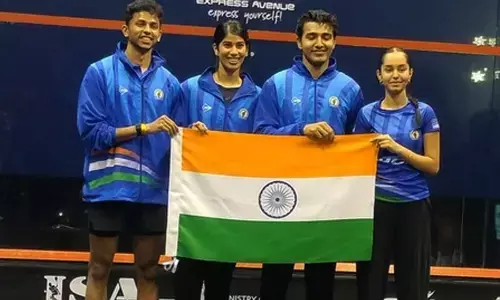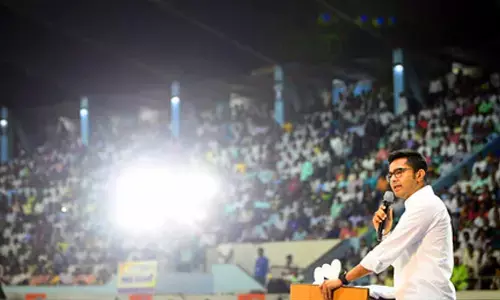Is there room for broom?
Is there room for broom?, High-profile politicians, Dr Jayaprakash Narayan. Nobody in the mainstream Indian politics would have thought a couple of months ago that the humble broom could be so lethal and devastating.
Nobody in the mainstream Indian politics would have thought a couple of months ago that the humble broom could be so lethal and devastating. Sheila Dikshit, a daughter-in-law of a high-profile politician, wife of a distinguished bureaucrat and mother of a spokesman of AICC, would not have used a broom in her elitist life. She is used to living in large bungalows, even before becoming a chief minister, with a number of servants in attendence. Congress president Sonia Gandhi or her son Rahul Gandhi would not have cared to look at a broom even if there was one at their house.
Dr Jayaprakash Narayan (JP) of Lok Satta also would not have wielded a wrecking bar in his life till he tried to demolish an illegal structure on the road at Vasant Nagar locality, in Kukatpally constituency represented by him in the State Assembly, on Monday. As a symbol of protest against the widespread corruption in Delhi, the broom was apt. The crowbar in Hyderabad city which is known for land-grabbing would be a suitable object to send a message to the people.
Soon after Kejriwal, the champion of the little man, took over the reins in Delhi from Sheila Diskhit, we, at the HMTV, organized a public debate to know if there is a room for the broom in Andhra Pradesh politics. The topic of the debate was “Kaun Banega AP ka Kejriwal( Who would be a Kejriwal in AP?)”. There was huge public response to the show and most of the young speakers were supporters of JP. They are too awed by JP’s personality to analyze his performance over 18 years after he left IAS. They revere him without questioning. After the public debate, JP went to Delhi and met Kejriwal who made it clear that the Aam Aadmi Party (AAP) is not in favour of pre-poll tie-up with any party. JP was hopeful of clinching the issue in his next visit. Even if he succeeds in persuading Kejriwal to agree for some sort of association, it is difficult for the JP school and the Kejriwal school to jell. Though, both of them have been fighting for a corruption-free society, their ways and means are different. While JP believes in macro politics, Kejriwal focuses on micro politics.
JP took up a number of issues in his political career. Most important of them are concerned with anti-graft campaign. Some of the Bills he helped draft have become laws. Unless the laws are implemented, the desired change would not materialize. For instance, after the Right to Information Act, 2005, came into being, there was a flood of petitions across the country. It was the weapon Kejriwal used effectively to expose corruption in high places. There has been stinking corruption in Hyderabad since the RTI regime commenced. Thousands of crores were pocketed by the politician-bureaucrat-contractor clique in irrigation works alone. Outlays were raised for greater mobilization advance. There has been no transparency in the functioning of the government. Even in crisis period in which the position of the chief minister has become most untenable, files worth thousands of crores have been cleared by the government. The people are not aware of the details. The media does not bother. The RTI activists don’t have knowledge of the departmental clearances. Andhra Pradesh offers the most fertile ground for the rights activists. Had JP led a movement from the front consistently, he would have become a glowing symbol of anti-graft movement besides being able to save huge money for the exchequer. Had he taken up the issue of lack of toilets in government schools in Hyderabad, leave alone rest of AP, it would have endeared him to lakhs for students and parents.
The problem with JP appears to be that he considers himself national, not local. Even on Tuesday when he spoke after breaking his seven-hour fast, he was seen cross-checking the details with the local people. It sends the signal that JP does not belong there and that it is not in keeping with his stature to fight in the street to solve local problems. He may sincerely believe that the job of a legislator is to make laws which should take care of governance. But the people of Hyderabad have a different understanding of a legislator. They expect him to follow in the footsteps of late P Janardhan Reddy, who used to sit at his office right from 7 AM to enable his constituents to meet him before they went to their factories or offices. He used to be at their beck and call. He shared their happiness, pain and grief. Right or wrong, that is how an ideal legislator is viewed by the people. JP has no stomach for that kind of politics. He appointed someone as his representative to attend to the problems of the people of his constituency. JP’s image in the constituency, at the end of the day, depends on the work done or not done by his nominee. It only shows that the bureaucrat did not take leave of JP even after he took to social work and politics. He likes a pan-India image for himself. There is no doubt that there are some solid achievements to his credit, particularly in the field of electoral reforms. But he could not influence local politics because he did not concentrate enough on issues that are of critical importance for the local people.
Kejriwal made water, power and school education the primary issues and broom the election symbol. The common man enjoyed the central focus. The AAP leader mingled with the poor, spoke in their lingo and articulated their problems. Thus the poor and the lower middle class people in Delhi identified themselves with the new party. The trend shows Delhi experiment has created a national wave of sorts in favour of AAP.
In a large country like India, symbols are extremely important. Kejriwal took a leaf out of Mahatma Gandhi’s Salt March. He defied the law by cutting the wires of the electric meters to protest steep hike in power bills. When Gandhi chose salt tax as the symbol of defiance, many in the Congress Working Committee had misgivings. Jawaharlal Nehru was ambivalent. Sardar Patel suggested land revenue boycott instead. The Statesman, a prominent English newspaper, wrote about Gandhi’s choice of the symbol thus: “It is difficult not to laugh, and we imagine that would be the mood of most thinking Indians.” Lord Irwin, the then Viceroy, wrote to London saying , “At present the prospect of salt campaign does not keep me awake at night.” It is a different matter that when the campaign snowballed into a big movement Lord Irwin could not sleep for months till the second round table conference was held.
However, Chakravarti Rajagopalachari, the wise man from South India, saw the point in Gandhi’s decision. He told a public meeting at Tuticorin , “Suppose people rise in revolt, they cannot attack the abstract constitution or lead an army against proclamations or statutes. Civil disobedience is directed against the salt tax or the land tax or some other particular point-not that that is our final end, but for the time being it is our aim, and we must shoot straight.”
Gandhi chose salt tax as symbol because salt is used by everyone in the country. From Sabarmati ashram to Dandi, Gandhi focused only on Salt Satyagraha and nothing else. He set out with 74 volunteers on his journey of 370 km in 23 days to make salt defying the British. The act of Gandhi picking up a tiny lump of salt triggered a wide civil disobedience movement which saw about 80,000 persons arrested across the country. Nehru, who was skeptical at the outset, had realized the power of salt after the protests gathered steam. He remarked at the unprecedented popular response, “It seemed as though a spring had been suddenly released.” The first prime minister of India considered Salt Satyagraha as the high-water mark of his association with Gandhi and felt that its lasting importance was changing the attitudes of Indians. Martin Luther King, Jr., the black rights leader in the US who made history in 1960s, was also immensely influenced by the Salt March and Gandhi’s philosophy of nonviolent resistance.
Leaders who changed the course of history had always focused on small but significant issues which symbolized the popular urge and resentment. What the salt was in 1930 the broom is in 2013. Had JP started handling the crowbar as soon as he launched the Lok Satta party and stayed put in Hyderabad, the history of AP, if not the country, would, perhaps, have been different. Better late than never. If JP changes his tactics in tune with Kejriwal’s and goes about in a more aggressive fashion, there is no reason why he should not succeed.















